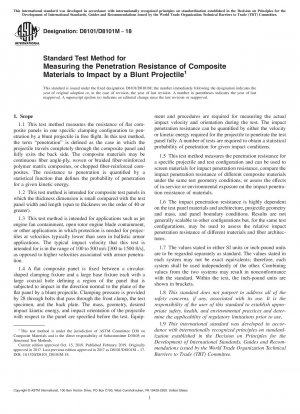ASTM D8101/D8101M-18
Standard Test Method for Measuring the Penetration Resistance of Composite Materials to Impact by a Blunt Projectile
- Standard No.
- ASTM D8101/D8101M-18
- Release Date
- 2018
- Published By
- American Society for Testing and Materials (ASTM)
- Latest
- ASTM D8101/D8101M-18
- Scope
- 1.1 This test method measures the resistance of flat composite panels in one specific clamping configuration to penetration by a blunt projectile in free flight. In this test method, the term “penetration” is defined as the case in which the projectile travels completely through the composite panel and fully exits the back side. The composite materials may be continuous fiber angle-ply, woven or braided fiber-reinforced polymer matrix composites, or chopped fiber-reinforced composites. The resistance to penetration is quantified by a statistical function that defines the probability of penetration for a given kinetic energy. 1.2 This test method is intended for composite test panels in which the thickness dimension is small compared with the test panel width and length (span to thickness on the order of 40 or greater). 1.3 This test method is intended for applications such as jet engine fan containment, open rotor engine blade containment, or other applications in which protection is needed for projectiles at velocities typically lower than seen in ballistic armor applications. The typical impact velocity that this test is intended for is in the range of 100 to 500 m/s [300 to 1500 ft/s], as opposed to higher velocities associated with armor penetration. 1.4 A flat composite panel is fixed between a circularshaped clamping fixture and a large base fixture each with a large coaxial hole defining a region of the panel that is subjected to impact in the direction normal to the plane of the flat panel by a blunt projectile. Clamping pressure is provided by 28 through bolts that pass through the front clamp, the test specimen, and the back plate. The mass, geometry, desired impact kinetic energy, and impact orientation of the projectile with respect to the panel are specified before the test. Equipment and procedures are required for measuring the actual impact velocity and orientation during the test. The impact penetration resistance can be quantified by either the velocity or kinetic energy required for the projectile to penetrate the test panel fully. A number of tests are required to obtain a statistical probability of penetration for given impact conditions. 1.5 This test method measures the penetration resistance for a specific projectile and test configuration and can be used to screen materials for impact penetration resistance, compare the impact penetration resistance of different composite materials under the same test geometry conditions, or assess the effects of in-service or environmental exposure on the impact penetration resistance of materials. 1.6 The impact penetration resistance is highly dependent on the test panel materials and architecture, projectile geometry and mass, and panel boundary conditions. Results are not generally scalable to other configurations but, for the same test configurations, may be used to assess the relative impact penetration resistance of different materials and fiber architectures. 1.7 The values stated in either SI units or inch-pound units are to be regarded separately as standard. The values stated in each system may not be exact equivalents; therefore, each system shall be used independently of the other. Combining values from the two systems may result in nonconformance with the standard. Within the text, the inch-pound units are shown in brackets. 1.8 This standard does not purport to address all of the safety concerns, if any, associated with its use. It is the responsibility of the user of this standard to establish appropriate safety, health, and environmental practices and determine the applicability of regulatory limitations prior to use. 1.9 This international standard was developed in accordance with internationally recognized principles on standardization established in the Decision on Principles for the Development of International Standards, Guides and Recommendations issued by the World Trade Organization Technical Barriers to Trade (TBT) Committee. 1 This test method is under the jurisdiction of ASTM Committee D30 on Composite Materials and is the direct responsibility of Subcommittee D30.05 on Structural Test Methods. Current edition approved Oct. 15, 2018. Published February 2019. Originally approved in 2017. Last previous edition approved in 2017 as D8101/D8101M – 17. DOI: 10.1520/D8101_D8101M-18. Copyright © ASTM International, 100 Barr Harbor Drive, PO Box C700, West Conshohocken, PA 19428-2959. United States This international standard was developed in accordance with internationally recognized principles on standardization established in the Decision on Principles for the Development of International Standards, Guides and Recommendations issued by the World Trade Organization Technical Barriers to Trade (TBT) Committee. 1
ASTM D8101/D8101M-18 Referenced Document
- ASTM A36/A36M Standard Specification for Carbon Structural Steel
- ASTM D3171 Standard Test Methods for Constituent Content of Composite Materials
- ASTM D3878 Standard Terminology Composite Materials
- ASTM D5229/D5229M Standard Test Method for Moisture Absorption Properties and Equilibrium Conditioning of Polymer Matrix Composite Materials
- ASTM D5687/D5687M Standard Guide for Preparation of Flat Composite Panels with Processing Guidelines for Specimen Preparation
- ASTM D792 Standard Test Methods for Density and Specific Gravity (Relative Density) of Plastics by Displacement
- ASTM D883 Standard Terminology Relating to Plastics*, 2024-02-01 Update
- ASTM E2533 Standard Guide for Nondestructive Examination of Polymer Matrix Composites Used in Aerospace Applications*, 2021-02-01 Update
ASTM D8101/D8101M-18 history
- 2018 ASTM D8101/D8101M-18 Standard Test Method for Measuring the Penetration Resistance of Composite Materials to Impact by a Blunt Projectile
- 2017 ASTM D8101/D8101M-17 Standard Test Method for Measuring the Penetration Resistance of Composite Materials to Impact by a Blunt Projectile
